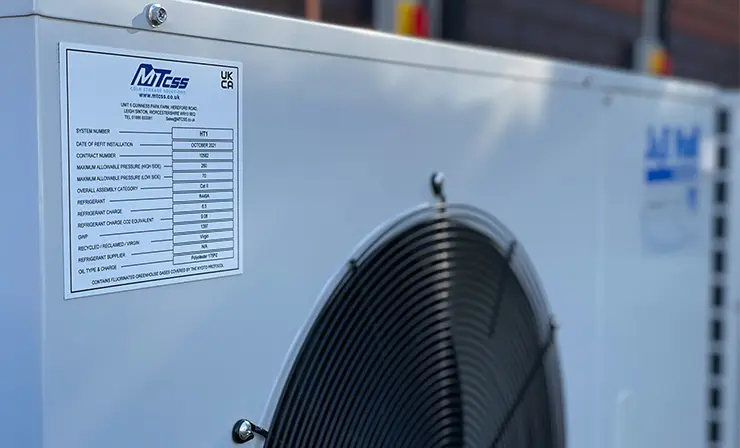The Future Of Environmentally Friendly Refrigerants
Understanding how your cold rooms and the refrigerants used in your temperature-controlled systems impact the environment, is key to understanding the longevity and sustainability of your cold storage solutions.
Refrigeration, air-conditioning, and temperature-control systems must adhere to the F-Gas phasedown and other regulations. What happens if your solutions don’t adhere to these regulations? As a business you are legally required to meet these regulations, or you may face hefty fines. At MTCSS we understand how this can be a minefield, which is why we are here to help!
In this article we look at the future of refrigerants – environmentally friendly gases to use in refrigeration systems which will adhere to F-Gas regulations and offer long-term use.
Refrigerant R449A – GWP 1397 ODP 0
The refrigerant R449A is a superior replacement to the commonly, and previously used, R404A. With a GWP of 1397 and an ODP of 0 it has a low environmental impact, a 67% reduction compared to R404A and R507, and an 8 to 12% high energy efficiency.
Benefits of refrigerant R449A:
- Non-flammable (with a safety classification at A1)
- Low to medium temperatures
- Can be used in new and existing systems
Although R499A doesn’t have the lowest GWP of the refrigerants in this article, it provides a long-term refrigerant solution as it adheres to strict F-Gas and HCFC phase out regulation. As well as offering a more environmentally friendly alternative to R404A.
A2L Refrigerants
A2L refrigerants are widely used refrigerants and are categorised according to a range of classifications, including:
- Low GWP
- Low flammability
- Lower toxicity
A defines the refrigerant as non-toxic, 2 defines the refrigerant as flammable, and L defines the refrigerant as low burning velocity. Due to these factors, they cannot be retrofitted or installed in existing refrigeration systems. A2L refrigerants can only be installed in new systems.
Despite A2Ls being classed as ‘mildly’ flammable, they are still considered a safe option for refrigeration, air conditioning, and heat pump applications. Why? Because they are difficult to ignite in these applications.
Refrigerant R32 – GWP 675 ODP 0 (A2L)
R32 falls into the class of A2L refrigerants and is commonly used in low temperature refrigeration and air conditioning applications. It is also often used as the preferred replacement of R410A – and has reduced environmental impact, and lower operating and maintenance costs.
Benefits of refrigerant R32:
- Low GWP of 675 and 0 ODP
- High energy efficiency
- Requires less volume of refrigerant per kW than other refrigerants (up to 20% less compared to R410A)
- Readily available and affordable
As R32 is a single component gas, this makes it easier to handle and simpler to recycle and reuse. It is also compliant with the F-Gas phasedown, so it will be able to be utilised in refrigeration and air conditioning systems in the long term.
Refrigerant R455A – GWP 146 ODP 0 (A2L)
R455A is considered to have an ultra-low GWP, having a much reduced impact on the environment compared to other refrigerants. R455A is a blend of refrigerants—R1234yf, R32, and CO2—it matches the capacity of the formerly used R404A and has a 5-6% improvement on efficiency.
Benefits of refrigerant R455A:
- High critical temperature
- Low critical pressure
- Low discharge temperature
A455A can be used in low, medium, and high applications for use in new systems. The refrigerant can be used in small charge, plug-in type cabinets; condensing units and monoblocks for cold rooms; and heat pumps.
Ultra-Low GWP Refrigerants
Butane, propane and CO2 all have an ultra-low GWP, from 1 to 4, and have the lowest environmental impact of the refrigerants listed.
Refrigerant R600 (Butane) – GWP 4 ODP 0
Butane, or R600, is suitable for a range of cooling applications. It is used in a variety of industrial, commercial, and domestic applications—its commonly used as a replacement for R12 and R134.
Benefits of refrigerant R600A:
- Low environmental impact
- Low power consumption and load power
- Good thermodynamic performance
- Compatible with many lubricants
Despite the benefits, butane is flammable and must be handled carefully, by trained technicians. Regulations and standards should always be adhered to in order to ensure safety. R600 cannot be used for retrofitting and due to its flammable nature, different charging and recovery procedures are required.
Refrigerant R290 (Propane) – GWP 3 ODP 0
R290, or propane, is used in low, medium, and high temperature refrigeration systems and air conditioning systems. But similarly to butane it is highly flammable and requires specialist handling.
Benefits of refrigerant R290:
- Low environmental impact
- Non-toxic
- High energy efficiency due to excellent thermodynamic properties
R290 can only be used in new systems, and not retrofitted in existing systems. It is commonly used as an alternative to R22 and R502.
Refrigerant R744 (CO2) – GWP 1 ODP 0
Due to R744’s ultra low GWP and other properties, CO2 is becoming increasingly popular for use a refrigerant and in temperature-controlled systems. It also has low energy requirements, meaning its highly efficient and has a safety classification of A1.
Benefits of refrigerant R744:
- Natural refrigerant with GWP 3 and ODP 0
- Excellent thermodynamic properties
- Non-flammable
- Can be used with other primary refrigerants eg. hydrocarbons and ammonia
Although R744A has a range of benefits, it has a high operating pressure—meaning the systems are more complex as they require high pressures for optimal functioning.
Refrigeration systems that contain R744 also require strict controls on moisture, oil, and other contaminants. These factors can result in an increased installation and commissioning cost due to the complexity.
If you’d like to discuss options for refrigerants in new cold rooms and refrigeration systems, or you’d like to understand the longevity and impact of the refrigerants used in your current systems – get in touch with the MTCSS team!
Call us on 01886 833381, email us at sales@mtcss.co.uk, or fill in an enquiry form below!


